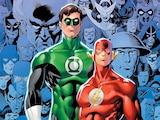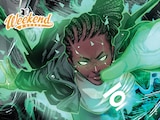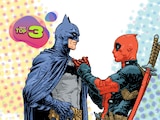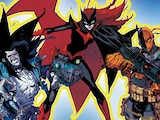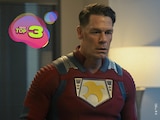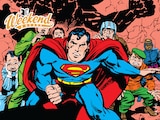Each Friday, we'll be letting a different DC.com writer share what they'll be reading over the weekend and why you might want to check it out. Here's this week's suggestion for a perfect Weekend Escape!
One of DC’s most iconic superheroes, Aquaman is a character whose lore is rife with mythic glory. With monikers like “The Sovereign of the Seven Seas,” readers should expect tales of epic heroism on a massive scale—after all, the Earth’s oceans cover over two-thirds of the planet. And indeed, Aquaman: Time and Tide features highly imaginative adventures that rightly suit DC’s Aquatic Ace. But dive deeper into the story and discover how there’s much more to Arthur than just his reputation as an Atlantean, king or a superhero. Through his own words, discover how Arthur views his life and his early beginnings—including his personal history, successes and failures—and how they’ve shaped him into the hero he is today. Let’s jump into the deep end of Aquaman: Time and Tide.
The Premise:

Our story is narrated by Aquaman in the present, writing about his early days as a young Atlantean. He’s a boy learning of his place in the world, and as a hero and king. Told out of chronological order, Arthur throws us into various scenarios which collectively form who he would later become in life. We’re shown his first encounter with a superhero and villain, in the form of the Flash and the Trickster. We see Arthur’s confusion at the hero and villain dynamic that’s already been established between the two.
For such a widely recognizable hero as Aquaman, it’s certainly something to see him look like a deer in the headlights in the middle of what’s a pretty typical comic book setup. Later sequences show his straining to become one with the ocean’s many creatures, befriending an Inupiat family whom he meets in his teen years, and his first encounter with one of his most dangerous arch-foes, Ocean Master. Each story depicts a younger, less developed version of the Aquaman who is presenting these adventures to us, and it’s interesting to see his earlier idealism and uncertainty contextualized by a more grizzled, contemplative Sea King.
Let’s Talk Talent:

Peter David begins his major stamp on the Aquaman character with this four-issue miniseries. Having laid the groundwork for his time with the character in his earlier saga The Atlantis Chronicles, here he takes on Arthur’s frame of mind while reflecting on the extreme events in his life. David is a writer whose flare for blending superhero traditions with grounded, relatable psychologies has done wonders in titles such as Supergirl and Young Justice. His Aquaman is one who is quick to act and always eager to protect those who cannot protect themselves. David depicts Aquaman as a man terribly conflicted with weighing the values of sea creatures and human beings, often working to save both from each other. David gives the character a distinct personality and outlook, which is readily different from that of a more traditional hero like the Flash, while also differentiating him from other Atlanteans like Ocean Master.
Ably enhancing this incisive storytelling is artist Kirk Jarvinen. His wide-eyed, stylish renderings on classic characters such as the Flash, Aqualad, Mera, Ocean Master and Aquagirl pop when put in stark contrast with the normality of the family of dolphins Arthur is raised by, or the Japanese fishermen he later encounters. An Inupiat family is featured heavily in the story, providing Jarvinen with a chance to highlight an often overlooked culture and visually differentiate their community from the undersea world Arthur has known. Jarvinen presents these different settings with equal amounts of realism and the dynamic quality readers want in a high-action superhero comic.
A Few Reasons to Read:

- As mentioned earlier, it’s a stunning look at an older Arthur commenting on a younger version of himself. Too often Aquaman is a hero who is defined by secondhand description. Not only is David and Jarvinen’s characterization of Arthur far more nuanced, but it gives the reader a real idea of the kind of person he’d have to be were he to exist with any believability.
- The Flash’s appearance is a brilliant way to bridge the gap between Arthur’s insular experience with the outside world and the larger DC Universe. Other heroes might have been eager to start a fight or see Aquaman as a potential threat, but Barry Allen just wants to extend a hand of friendship. It gives a good idea as to how Aquaman would go on to become a founding member of the Justice League of America.
- Issue #3 is a standout in how it takes place entirely in Alaska. Seeing how Arthur interacts with a different group of people, especially when his presence invokes a dangerous myth of their Inuit religion, is a fun curveball for the reader and pushes our hero into new territory that advances his character in unexpected ways.
Why It’s Worth Your Time:

For many people unfamiliar with the comics, Aquaman is too often a character talked about and not shown. This four-issue miniseries is a simple yet iconic depiction of a man who struggles between two worlds as he’s tasked to protect them both, culminating in a classic interpretation of the King of the Seas that’s informed by a lifetime of personal and psychological struggle. If you’re getting ready for Aquaman and the Lost Kingdom and want to learn more about its titular hero, you could do a lot worse than spending your weekend savoring Aquaman: Time and Tide!
Aquaman: Time and Tide by Peter David, Kirk Jarvinen, Brad Vancata and Tom McCraw can be read in full on DC UNIVERSE INFINITE.
Donovan Morgan Grant writes about comics, graphic novels and superhero history for DC.com. Follow him on Twitter at @donoDMG1.
NOTE: The views and opinions expressed in this feature are solely those of Donovan Morgan Grant and do not necessarily reflect those of DC Entertainment or Warner Bros., nor should they be read as confirmation or denial of future DC plans.


